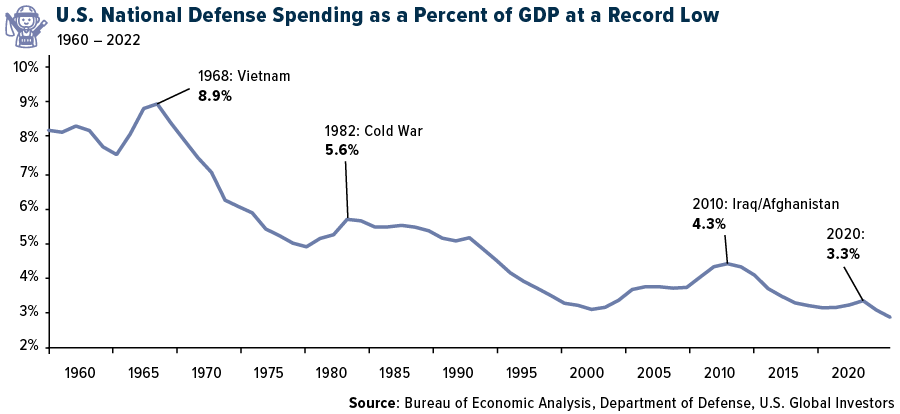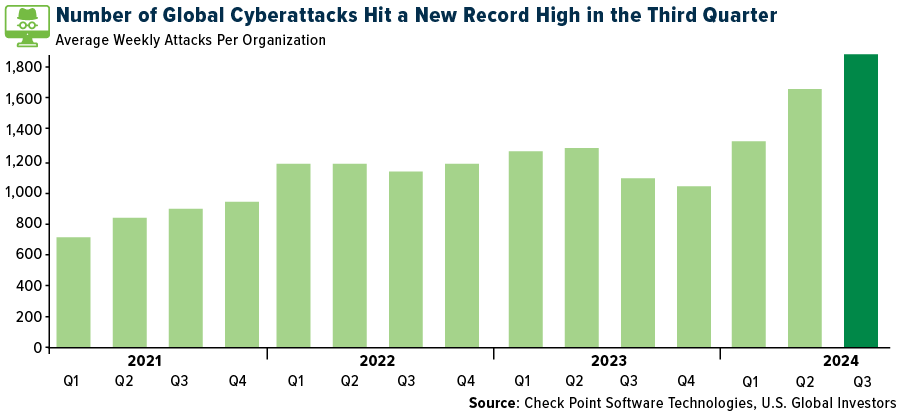With President-elect Donald Trump set to assume office in January, the U.S. military and cybersecurity sectors could experience sweeping changes, creating opportunities for investors who recognize the long-term growth potential in defense and technology.
In his first term, President Trump left his mark on the U.S. military, establishing the Space Force and boosting defense spending to historic highs.
Now, as he prepares for his second term, his administration’s ambitious goals—such as potentially creating an Iron Dome Missile Defense Shield system—signal a renewed focus on military modernization.
Meanwhile, cyber threats have reached an all-time high, requiring unprecedented investment in cybersecurity infrastructure. For investors, these trends highlight two critical sectors poised for growth: traditional defense and the emerging field of cyber defense.
The State of U.S. Defense Spending
In 2023, U.S. military expenditure reached $916 billion, representing a staggering 40% of global military spending. As I shared with you earlier in the year, that’s more than the next 10 countries combined.
Despite this eye-popping figure, U.S. defense spending as a share of GDP has been falling steadily for decades and recently hit an historic low, a function of the U.S. economy growing faster than military spending.

I believe this highlights an important point: While the U.S. spends more on defense than any other nation, there’s still room for growth, particularly as new threats emerge on both physical and virtual battlefields.
The Congressional Budget Office (CBO) projects that military spending will increase 10% between 2028 and 2038, adjusted for inflation. But Republicans could accelerate this timeline, with bold initiatives like the proposed Iron Dome-style missile defense system.
NATO Members Expected to Boost Expenditures
The potential for increased defense budgets isn’t limited to the U.S. NATO allies, under renewed pressure from an incoming Trump administration, are likely to ramp up their own spending.
Germany, for example, has already met NATO’s 2% GDP defense target for the first time in decades, and public opinion now supports raising it even further to between 3% and 3.5%. Poland currently leads the alliance by spending a whopping 4.12% of GDP on defense, and next year, that figure is expected to rise to 5%.
Cybersecurity: The New Frontline
While traditional military spending captures the headlines, the cybersecurity sector represents an equally important—and arguably more urgent, I think—investment opportunity. Recent data by Check Point Software Technologies reveals that cyberattacks have skyrocketed, with the average number of weekly attacks climbing 75% globally year-over-year, to hit a record high of 1,876 per organization. In the U.S., attacks are up 56% from 2023 levels, averaging 1,300 per organization weekly.

The culprits aren’t just rogue hackers but state-sponsored actors from powerful nations like China, Russia and Iran, according to Microsoft’s Digital Defense Report 2024.
These adversaries are no longer content with merely breaching corporate networks. They target critical infrastructure, telecommunications and even political figures. A recent campaign by Chinese state-sponsored hackers infiltrated the phones of Trump, Vice President-elect JD Vance and Vice President Kamala Harris, underscoring the growing national security implications of these attacks.
As businesses, governments and individuals race to protect themselves from these threats, the need for robust cybersecurity will only increase. For investors, this means that companies developing cutting-edge technology to secure networks and data could be positioned for explosive growth.
Challenges and Opportunities
Defense and cybersecurity budgets tend to receive bipartisan support, but Trump’s return could supercharge growth. His track record—and his recent, controversial nomination of Fox News host Pete Hegseth as defense secretary—suggests a willingness to take bold steps to reshape the U.S. military and strengthen the nation’s defenses against 21st-century threats.
As we look ahead to 2024 and beyond, it’s clear that military and cybersecurity spending are on an upward trajectory. The challenges of tomorrow—whether they come in the form of hypersonic missiles or sophisticated cyberattacks—require innovative solutions and significant investment. For investors, this represents not just a challenge but an opportunity.
Related: The Safety and Protection Message That Helped Trump Prevail


